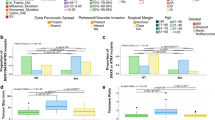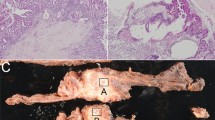Abstract
Carcinoid tumors and pancreatic endocrine tumors (PETs) are uncommon neuroendocrine neoplasms and their genetic alterations are not well characterized. CpG island methylation is a mechanism of gene silencing, and concordant methylation of multiple CpG islands as CpG island methylator phenotype (CIMP) has been described in tumors. The aim of this study was to evaluate CIMP in carcinoid tumors and PETs. We studied 16 carcinoid tumors, 11 PETs, and 22 associated normal mucosa or pancreas. Methylation status of the p14, p16, cyclo-oxygenase 2 (COX2), O6-methyl-guanine methyltransferase (MGMT), estrogen receptor (ER), thrombospondin 1 (THBS1), retinoic acid receptor beta 2 (RARβ), T-type calcium channel (CACNA1G), and multiple endocrine neoplasia type-1 (MEN1) genes, and of MINT1, MINT2, MINT25, MINT27 and MINT31 loci was evaluated by methylation-specific-PCR (MSP) or combined bisulfite restriction analysis (COBRA). Carcinoid tumors were frequently methylated at RARβ, MGMT, p16, COX2, p14, THBS1, and ER ranging from 25 to 63% of tumors. Other CpG islands were infrequently methylated or unmethylated. The adjoining normal mucosa was also methylated for ER, COX2, and RARβ, but methylation at p14, p16, THBS1, and MGMT was tumor-specific. By contrast, PETs and normal pancreas were frequently methylated only at ER. Methylation was more frequent in carcinoid tumors than PETs at MGMT (25 versus 0%, p=0.03), THBS1 (44 versus 9%, p=0.04), p14 (44 versus 9%, p=0.04) and RARβ (25 versus 0%, p=0.03). Loss of p16 protein expression correlated with methylation of p16 gene in carcinoid tumors (p=0.006). Our study indicates that methylation profile of carcinoid tumors differs from PETs, reflecting different molecular pathogenesis.
This is a preview of subscription content, access via your institution
Access options
Subscribe to this journal
Receive 50 print issues and online access
$259.00 per year
only $5.18 per issue
Buy this article
- Purchase on Springer Link
- Instant access to full article PDF
Prices may be subject to local taxes which are calculated during checkout






Similar content being viewed by others
Abbreviations
- COBRA:
-
combined bisulfite restriction analysis
- CIM:
-
CpG island methylation
- CIMP:
-
CpG island methylator phenotype
- COX2:
-
cyclo-oxygenase 2
- ER:
-
Estrogen receptor
- LOH:
-
loss of heterozygosity
- MSP:
-
methylation specific-PCR
- MEN1:
-
multiple endocrine neoplasia type-1
- MGMT:
-
O6-methyl-guanine methyltransferase
- PETs:
-
pancreatic endocrine tumors
- RARβ:
-
retinoic acid receptor beta 2
- THBS1:
-
thrombospondin 1
- CACNA1G:
-
T-type calcium channel
References
Ahuja N, Li Q, Mohan AL, Baylin SB and Issa JP . (1998). Cancer Res., 58, 5489–5494.
Baylin SB, Esteller M, Rountree MR, Bachman KE, Schuebel K and Herman JG . (2001). Hum. Mol. Genet., 10, 687–692.
Bird AP . (1986). Nature, 321, 209–213.
Calender A . (1999). Recent Advances in the Pathophysiology and Management of Inflammatory Bowel Diseases and Digestive Endocrine Tumors: New Insights in Genetics of Digestive Neuroendocrine Tumors. Mignon M and Colombel JF (eds). John Libbey Eurotext Publishing: Paris, pp 155–161.
Capella C, Solcia E, Sobin LH and Arnold R . (2000). World Health Organization Classification of Tumors: Pathology and Genetics of Tumors of the Digestive System. Hamilton SR, and Aaltonen LA (eds). IARC Press: Lyon, pp 53–56, 77–82, 99–101, and 137–138.
Eads CA, Lord RV, Wickramasinghe K, Long TI, Kurumboor SK, Bernstein L, Peters JH, DeMeester SR, DeMeester TR, Skinner KA and Laird PW . (2001). Cancer Res., 61, 3410–3418.
Eberhart CE, Coffey RJ, Radhika A, Giardiello FM, Ferrenbach S and DuBois RN . (1994). Gastroenterology, 107, 1183–1188.
Esteller M, Hamilton SR, Burger PC, Baylin SB and Herman JG . (1999). Cancer Res., 59, 793–797.
Esteller M, Tortola S, Toyota M, Capella G, Peinado MA, Baylin SB and Herman JG . (2000). Cancer Res., 60, 129–133.
Fujimori M, Ikeda S, Shimizu Y, Okajima M and Asahara T . (2001). Cancer Res., 61, 6656–6659.
Godwin JD . (1975). Cancer, 36, 560–569.
Görtz B, Roth J, Krähenmann A, de Krijger RR, Muletta-Feurer S, Rütimann K, Saramaslani P, Speel EJM, Heitz PU and Komminoth P . (1999). Am. J. Pathol., 154, 429–436.
Herman JG, Graff JR, Myohanen S, Nelkin BD and Baylin SB . (1996). Proc. Natl. Acad Sci USA, 93, 9821–9826.
Herman JG, Merlo A, Mao L, Lapidus RG, Issa JP, Davidson NE, Sidransky D and Baylin SB . (1995). Cancer Res., 55, 4525–4530.
Jensen RT . (1999). Recent advances in the Pathophysiology and Management of Inflammatory Bowel Diseases and Digestive Endocrine Tumors: Natural History of Digestive Endocrine Tumors. Mignon M and Colombel JF (eds). John Libbey Eurotext Publishing: Paris, pp 192–219.
Konishi N, Nakamura M, Kishi M, Nishimine M, Ishida E and Shimada K . (2002). Am. J. Pathol., 160, 1207–1214.
Li Q, Ahuja N, Burger PC and Issa JP . (1999). Oncogene, 18, 3284–3289.
Lim HY, Joo HJ, Choi JH, Yi JW, Yang MS, Cho DY, Kim HS, Nam DK, Lee KB and Kim HC . (2000). Clin. Cancer Res., 6, 519–525.
Lubomierski N, Kersting M, Bert T, Muench K, Wulbrand U, Schuermann M, Bartsch D and Simon B . (2001). Cancer Res., 61, 5905–5910.
Marx SJ . (1999). Recent Prog. Review Horm. Res., 54, 397–438.
Mignon M . (2000). Digestion, 62(Suppl. 1), 51–58.
Muscarella P, Melvin WS, Fisher WE, Foor J, Ellison EC, Herman JG, Schirmer WJ, Hitchcock CL, DeYoung BR and Weghorst CM . (1998). Cancer Res., 58, 237–240.
Oshima M, Dinchuk JE, Kargman SL, Oshima H, Hancock B, Kwong E, Trzaskos JM, Evans JF and Taketo MM . (1996). Cell, 87, 803–809.
Rashid A, Gao Y-T, Bhakta S, Shen M-C, Wang B-S, Deng J, Fraumeni Jr JF and Hsing AW . (2001). Cancer Res., 61, 3406–3409.
Rindi G, Candusso ME and Solcia E . (1999a). Ital. J. Gastroenterol. Hepatol., 31(Suppl. 2), S135–S138.
Rindi G, Capella C and Solcia E . (1999b). Recent Advances in the Pathophysiology and Management of Inflammatory Bowel Diseases and Digestive Endocrine Tumors: Pathobiology and Classification of Gut Endocrine Tumors. Mignon M, and Colombel JF (eds). John Libbey Eurotext Publishing: Paris, pp 177–191.
Ristimaki A, Honkanen N, Jankala H, Sipponen P and Harkonen M . (1997). Cancer Res., 57, 1276–1280.
Roberts DD . (1996). FASEB J., 10, 1183–1191.
Roman SD, Clarke CL, Hall RE, Alexander IE and Sutherland RL . (1992). Cancer Res., 52, 2236–2242.
Ruas M and Peters G . (1998). Biochim. Biophys. Acta, 1378, F115–F177.
Seewaldt VL, Johnson BS, Parker MB, Collins SJ and Swisshelm K . (1995). Cell. Growth Differ., 6, 1077–1088.
Serrano J, Goebel SU, Peghini PL, Lubensky IA, Gibril F and Jensen RT . (2000). J. Clin. Endo. Metab., 85, 4146–4156.
Serrano M, Lee H, Chin L, Cordon-Cardo C, Beach D and DePinho RA . (1996). Cell, 85, 27–37.
Solcia E, Capella C and Kloppel G (eds). (1997). Atlas of Tumor Pathology: Tumors of the Pancreas. Armed Forces Institute of Pathology: Washington, DC. pp. 145–210.
Swisshelm K, Ryan K, Lee X, Tsou HC, Peacocke M and Sager R . (1994). Cell. Growth Differ., 5, 133–141.
Toyooka S, Toyooka OK, Maruyama R, Virmani AK, Girard L, Miyajima K, Harada K, Ariyoshi Y, Takahashi T, Sugio K, Brambilla E, Gilcrease M, Minna JD and Gazdar AF . (2001). Mol. Cancer Ther., 1, 61–67.
Toyota M, Ahuja N, Ohe-Toyota M, Herman JG, Baylin SB and Issa J-PJ . (1999a). Proc. Natl. Acad. Sci. USA, 96, 8681–8686.
Toyota M, Ahuja N, Suzuki H, Itoh F, Ohe-Toyota M, Imai K, Baylin SB and Issa JP . (1999b). Cancer Res., 59, 5438–5442.
Toyota M, Ho C, Ohe-Toyota M, Baylin SB and Issa JP . (1999c). Cancer Res., 59, 4535–4541.
Toyota M, Kopecky KJ, Toyota MO, Jair KW, Willman CL and Issa JP . (2001). Blood, 97, 2823–2829.
Toyota M, Shen L, Ohe-Toyota M, Hamilton SR, Sinicrope FA and Issa J-PJ . (2000). Cancer Res., 60, 4044–4048.
Uefuji K, Ichikura T and Mochizuki H . (2000). Clin. Cancer Res., 6, 135–138.
Ueki T, Toyota M, Sohn T, Yeo CJ, Issa JP, Hruban RH and Goggins M . (2000). Cancer Res., 60, 1835–1839.
Virmani AK, Rathi A, Zochbauer-Muller S, Sacchi N, Fukuyama Y, Bryant D, Maitra A, Heda S, Fong KM, Thunnissen F, Minna JD and Gazdar AF . (2000). J. Natl. Cancer Inst., 92, 1303–1307.
Weber HC and Jensen RT . (1996). Advances in Pancreatic Disease: Molecular Biology, Diagnosis and Treatment: Pancreatic Endocrine Tumors and Carcinoid Tumors: Recent Insights from Genetic and Molecular Biologic Studies. Dervenis CG (ed). Georg Thieme Verlag: New York, pp 55–75.
Widschwendter M Berger J Hermann M Muller HM Amberger A Zeschnigk M Widschwendter A Abendstein B Zeimet AG Daxenbichler G and Marth C . (2000). J. Natl. Cancer Inst., 92, 826–832.
Xiong Z and Laird PW . (1997). Nucleic Acids Res., 25, 2532–2534.
Author information
Authors and Affiliations
Rights and permissions
About this article
Cite this article
Chan, AO., Kim, S., Bedeir, A. et al. CpG island methylation in carcinoid and pancreatic endocrine tumors. Oncogene 22, 924–934 (2003). https://doi.org/10.1038/sj.onc.1206123
Received:
Revised:
Accepted:
Published:
Issue Date:
DOI: https://doi.org/10.1038/sj.onc.1206123
Keywords
This article is cited by
-
Expression and methylation status of MMR and MGMT in well-differentiated pancreatic neuroendocrine tumors and potential clinical applications
Endocrine (2022)
-
Multilayered heterogeneity as an intrinsic hallmark of neuroendocrine tumors
Reviews in Endocrine and Metabolic Disorders (2018)
-
Towards a new classification of gastroenteropancreatic neuroendocrine neoplasms
Nature Reviews Clinical Oncology (2016)
-
Clinicopathological Significance of CDKN2A Promoter Hypermethylation Frequency with Pancreatic Cancer
Scientific Reports (2015)
-
O6-Methylguanine-DNA methyltransferase status in neuroendocrine tumours: prognostic relevance and association with response to alkylating agents
British Journal of Cancer (2015)



